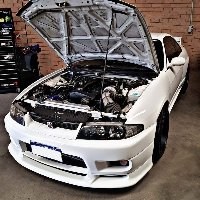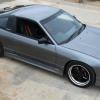Dba 4000 T3 Rotors - Catastrophic Failure At Track
Announcements
-
Similar Content
-
Latest Posts
-
Well, after the full circus this week (new gearbag, 14 psi actuator on, injectors and AFM upgraded, and.....turbo repair) the diagnosis on the wastegate is in. It was broken. It was broken in a really strange way. The weld that holds the lever arm onto the wastegate flapper shaft broke. Broke completely, but broke in such a way that it could go back together in the "correct" position, or it could rearrange itself somewhere else along the fracture plane and sit with the flapper not parallel to the lever. So, who knows how and when exactly what happened? No-one will ever know. Was it broken like this the first time it spat the circlip and wedged itself deep into the dump? Or was it only broken when I tried to pry it back into place? (I didn't try that hard, but who knows?). Or did it break first? Or did it break between the first and second event of wierdness? Meh. It doesn't matter now. It is welded back together. And it is now held closed by a 14 psi actuator, so...the car has been tuned with the supporting mods (and the order of operations there is that the supporting mods and dyno needed to be able to be done first before adding boost, because it was pinging on <<14 psi with the new turbo with only a 6 psi actuator). And then tuned up a bit, and with the boost controller turned off throughout that process. So it was only running WG pressure and so only hit about 15-16 psi. The turbo is still ever so slightly lazier than might be preferred - like it is still a bit on the big side for the engine. I haven't tested it on the road properly in any way - just driven it around in traffic for a half hour or so. But it is like chalk and cheese compared to what it was. Between dyno numbers and driving feedback: It makes 100 kW at 3k rpm, which is OK, could be better. That's stock 2JZ territory, or RB20 with G series 550. It actually starts building boost from 2k, which is certainly better than it did recently (with all the WG flapper bullshit). Although it's hard to remember what it was like prior to all that - it certainly seems much, much better. And that makes sense, given the WG was probably starting to blow open at anything above about 3 psi anyway (with the 6 psi actuator). It doesn't really get to "full boost" (say 16 psi) until >>4k rpm. I am hopeful that this is a feature of the lack of boost controller keeping boost pressure off the actuator, because it was turned off for the dyno and off for the drives afterward. There's more to be found here, I'm sure. It made 230 rwkW at not a lot more than 6k and held it to over 7k, so there seems to be plenty of potential to get it up to 250-260rwkW with 18 psi or so, which would be a decent effort, considering the stock sized turbo inlet pipework and AFM, and the return flow cooler. According to Tao, those things should definitely put a bit of a limit on it by that sort of number. I must stress that I have not opened the throttle 100% on the road yet - well, at least not 100% and allowed it to wind all the way up. It'll have to wait until some reasonable opportunity. I'm quite looking forward to that - it feels massively better than it has in a loooong time. It's back to its old self, plus about 20% extra powers over the best it ever did before. I'm going to get the boost controller set up to maximise spool and settle at no more than ~17 psi (for now) and then go back on the dyno to see what we can squeeze out of it. There is other interesting news too. I put together a replacement tube to fit the R35 AFM in the stock location. This is the first time the tuner has worked with one, because anyone else he has tuned for has gone from Z32 territory to aftermarket ECU. No-one has ever wanted to stay Nistuned and do what I've done. Anyway, his feedback is that the R35 AFM is super super super responsive. Tiny little changes in throttle position or load turn up immediately as a cell change on the maps. Way, way more responsive than any of the old skool AFMs. Makes it quite diffifult to tune as you have to stay right on top of that so you don't wander off the cell you wanted to tune. But it certainly seems to help with real world throttle response. That's hard to separate from all the other things that changed, but the "pedal feel" is certainly crisp.
-
By Murray_Calavera · Posted
I'm a bit confused by this post, so I'll address the bit I understand lol. Use an air compressor and blow away the guide coat sanding residue. All the better if you have a moisture trap for your compressor. You'd want to do this a few times as you sand the area, you wouldn't for example sand the entire area till you think its perfect and then 'confirm' that is it by blowing away the guide coat residue. Sand the area, blow away the guide coat residue, inspect the panel, back to sanding... rinse and repeat. -
The detail level is about right for the money they charge for the full kit... AU$21.00 each issue, 110 issues for a total of $2,300 (I mentioned $2.2K in the first post when the exchange rate was better). $20/week is doable... 😐
-
If planning on joining us for the day(s) please indicate by filling in this form. https://forms.gle/Ma8Nn4DzYVA8uDHg7
-
By soviet_merlin · Posted
You put the driver's seat on the wrong side! Incredible detail on all of this. It looks like you could learn a lot about the car just from assembling the kit.
-










Recommended Posts
Create an account or sign in to comment
You need to be a member in order to leave a comment
Create an account
Sign up for a new account in our community. It's easy!
Register a new accountSign in
Already have an account? Sign in here.
Sign In Now